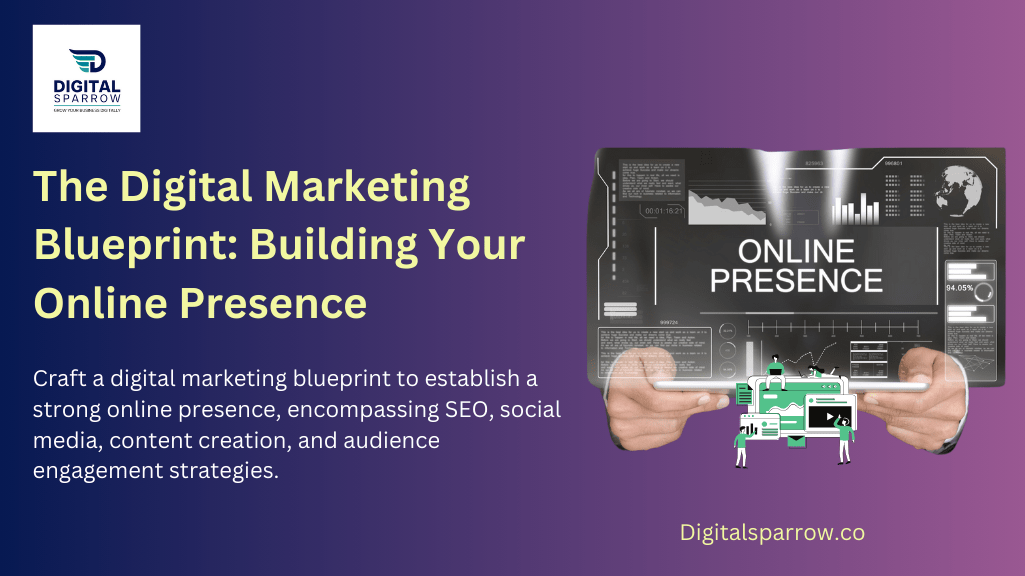Table of contents
• Introduction• Defining Your Goals • Understanding Your Target Audience• Building a User-Friendly Website• Content Creation • Search Engine Optimization (SEO) • Social Media Marketing • Email Marketing • Analytics and Metrics • Conclusion
Introduction
We’re glad you’re here at The Digital Marketing Blueprint: The Ultimate Guide to Building Your Online Presence! Businesses today need a strong online presence to be relevant in the digital age. To reach your target audience, it is essential to have an online presence that describes how visible and approachable your company is online. The practice of selling your company’s name, goods, or services via numerous online channels is known as digital marketing. It entails a variety of strategies, such as using email marketing, social media exploitation, website search engine optimisation, and content creation that is engaging. Connecting with your audience online, where they spend the majority of their time, is the core of digital marketing, to put it simply. It’s time to delve more deeply now that you are aware of how crucial digital marketing and internet presence are. Let’s look at how to create a thorough digital marketing plan that will assist you in achieving your objectives.
Defining Your Goals
Setting goals is crucial before stepping into the world of digital marketing. What is it that you hope to accomplish with your web presence? Is it greater customer involvement, lead generation, brand awareness, or revenue growth? You may organize your digital marketing activities in accordance with your goals by stating them explicitly.
Understanding Your Target Audience
You must comprehend the tastes, needs, and behaviors of your audience in order to engage them online. Create buyer profiles, analyze your current clientele, and conduct market research to learn more about your target audience’s characteristics, interests, and online behaviors. Your ability to properly adjust your digital marketing initiatives so that they appeal to your target audience will be made possible by this information.
Building a User-Friendly Website
As the central digital location of your online presence, your website functions as this. Ascertain that it is aesthetically pleasing, user-friendly, and responsive to mobile devices. Include relevant keywords, meta descriptions, and high-quality content to make it search engine-optimized. To increase user engagement and aid conversions, also include calls to action that are clear, contact details, and links to social media accounts.
Content Creation
An effective approach for content generation is necessary to establish a strong online presence. Identifying your target audience is the first step. You need to know who they are, what they need, what interests them, and where they go online. Once you have identified these needs and have ensured that your content strategy is in line with your brand’s voice and message, you can start creating content. To maintain your audience’s interest and investment, however, more than just producing content is required. Examine several content types, including blogs, videos, infographics, and social media posts. To keep your readers interested, use attention-grabbing titles, eye-catching graphics, and simple language. You need to market and disseminate the material using a variety of channels, including social media, email marketing, and SEO strategies. It’s not just about pumping out content either. You can do this to reach a larger audience and increase traffic to your website. Just remember to keep an eye on how well your material is performing and regularly assess it to determine what resonates with your audience and modify your strategy as necessary.
Know about best google algorithms
Search Engine Optimization (SEO)
Google search engine optimisation (SEO) Your website now has some truly excellent stuff. Congrats! However, how can you get the correct audience to see it? To solve this problem, SEO is used. To determine what terms your audience is using to search online, you must first conduct some keyword research. To identify pertinent keywords with a large search volume and little competition, use programmes like Google Keyword Planner or SEMrush. When you have your list of keywords, be sure to naturally include them into your article. Next, Your website needs to be search engine optimized after that. This covers both on-page optimisation strategies like adding meta descriptions, title tags, and header tags to your web pages as well as off-page strategies like link building and guest blogging. However, avoid becoming overly engrossed in SEO’s complex technicalities. The goal is to produce valuable content for your audience, which is what matters most in the end. The SEO will naturally follow if you put your attention there.
Social Media Marketing
Social media marketing: Ah, the wonderful social media. Let’s face it: We love the platform that has taken over our lives. But how can you determine which platform is best for your company? Should you make an investment in LinkedIn, Twitter, Instagram, or Facebook? It all depends on who your target market is, though. LinkedIn is the best platform for B2B enterprises, whereas Facebook is better for B2C firms. For those visually appealing posts, Instagram is ideal, while Twitter is wonderful for fast updates. The moment has come for you to create a social media plan now that you have chosen the appropriate platform or platforms. A content calendar, goal-setting, and establishing your brand voice are all part of this. Always keep in mind that consistency is essential. Let’s now discuss the differences between paid and organic marketing methods. While paid advertising can increase your audience reach and engagement, it’s crucial to also pay attention to organic tactics. To do this, interact with your followers, share user-generated material, and use pertinent hashtags. Creating deep connections with your audience is the main goal of social media marketing in the end. So feel free to interact with your fans by being quirky and personal.
Kindly read the blogs for new startup for unlocking the potential benefits.
Email Marketing
The effectiveness of email marketing, ah? It’s the best technique to effectively and immediately communicate with your audience. Let’s now discuss the main factors to concentrate on while developing your email marketing strategy: Creating an email list is important first. Make sure they consciously sign up for your newsletter if you want to reach the people who are actually interested in your business. Second, to create successful email marketing, you must understand your target market, stay consistent, and use a compelling call-to-action. Last but not least, the methods used to determine success differ from business to business and may include open rates, click-through rates, or even revenue figures. No matter what you monitor, ongoing testing and analysis will help you gradually enhance your campaigns. Send out more email blasts!

Analytics and Metrics
Let’s now discuss metrics and analytics. These are essential components of any digital marketing strategy since they enable you to monitor the success of your online presence. Although there are several systems and tools for tracking metrics, Google Analytics is the most often used one. It provides you with a comprehensive overview of user behavior on your website, including demographics, bounce rates, and conversion rates. It is equally crucial to interpret and put data insights into practice. You can refine your online presence, increase engagement, and raise ROI thanks to it. For instance, you may need to change your content strategy if your website’s bounce rate is too high in order to make it more interesting and pertinent to your target audience. Don’t let metrics and statistics get out of hand, though. Remember that you’re selling to people, not machines, even though gathering and analyzing data is important. Feedback from your audience is essential because it helps you spot chances for expansion and provides you with information about areas that need development.
Conclusion
So there you have it – the ultimate approach to developing your online presence. We’ve discussed the importance of digital marketing and how it may help you reach your target audience more successfully. Remember to define your audience, build a content strategy, and create compelling material for your website and social media channels. Don’t overlook SEO, which comprises both on-page and off-page strategies aimed at increasing your website’s exposure in search engine results pages. You should also investigate social media platforms and email marketing efforts to boost your internet presence. To begin, track your progress using various analytics and metrics tools while evaluating and implementing data insights. Follow these guidelines and begin establishing your web presence right away!


Thank you for your sharing. I am worried that I lack creative ideas. It is your article that makes me full of hope. Thank you. But, I have a question, can you help me?
Can you be more specific about the content of your article? After reading it, I still have some doubts. Hope you can help me.
Can you please share your doubts so that we can cover those in the upcoming blogs!